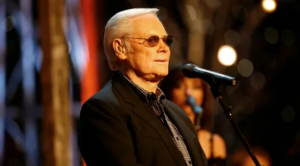
“The Honky Tonk Downstairs” is a timeless classic recorded by the legendary country music singer George Jones. Released in 1962, this song quickly became a staple of Jones’ repertoire and a beloved anthem among country music fans. Penned by Bill Anderson and Kent Westberry, the song paints a vivid picture of a heartbroken man seeking solace in the familiar confines of a honky-tonk bar.
Jones’ emotive vocals, coupled with the poignant lyrics and the song’s melancholic melody, have resonated with audiences for decades. The track’s enduring popularity is a testament to Jones’ exceptional talent as a singer and the song’s universal themes of heartbreak, loneliness, and the allure of the honky-tonk.
Historical Context
George Jones emerged as one of the most influential figures in country music during the 1950s and 1960s. Known for his distinctive vocal style, often described as “nosy,” Jones’ music blended elements of traditional country, honky-tonk, and Western swing. His career was marked by numerous hit songs, including “White Lightning,” “She Thinks I Still Care,” and “The Race Is On.”
The Honky Tonk Downstairs was released at a pivotal time in Jones’ career. He had already established himself as a rising star, but this song solidified his position as one of the genre’s leading voices. The track’s success helped to define Jones’ sound and image, and it remains one of his most recognizable songs to this day.
Song Analysis
The Honky Tonk Downstairs opens with a haunting melody played on a steel guitar. Jones’ vocals then enter, delivering the opening lines with a sense of resignation and longing:
Well, I walked into that honky-tonk feeling so low Just wanted to drown my sorrows, let the old tears flow
These lines immediately set the scene for the song, establishing the narrator’s emotional state and the reason for his presence in the bar. The honky-tonk, a symbol of both solace and temptation, becomes a central character in the song.
The lyrics continue to explore the narrator’s heartbreak and his attempts to cope with his pain. He describes the familiar faces he sees in the bar, the jukebox playing his favorite songs, and the bittersweet memories that come flooding back. The honky-tonk becomes a microcosm of the narrator’s world, a place where he can both escape from his troubles and confront them head-on.
Jones’ vocal performance is a masterclass in emotional expression. His voice conveys a range of emotions, from sadness and despair to defiance and resignation. He delivers the song’s lines with a raw intensity that pulls the listener into the heart of the story.
The song’s arrangement is simple yet effective, featuring a sparse instrumentation that allows Jones’ vocals to take center stage. The steel guitar provides a mournful counterpoint to the singer’s voice, while the rhythm section provides a steady pulse that drives the song forward.
Video
Legacy
The Honky Tonk Downstairs has had a profound impact on country music. It has been covered by numerous artists, including Alan Jackson, Willie Nelson, and Vince Gill. The song’s enduring popularity is a testament to its timeless themes and Jones’ exceptional talent.
Today, The Honky Tonk Downstairs remains a beloved classic that continues to resonate with audiences of all ages. It is a song that captures the essence of country music, with its themes of heartbreak, loneliness, and the allure of the honky-tonk.